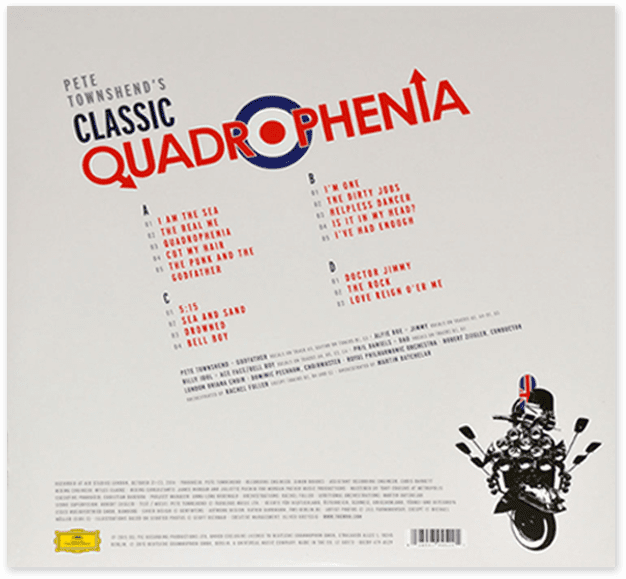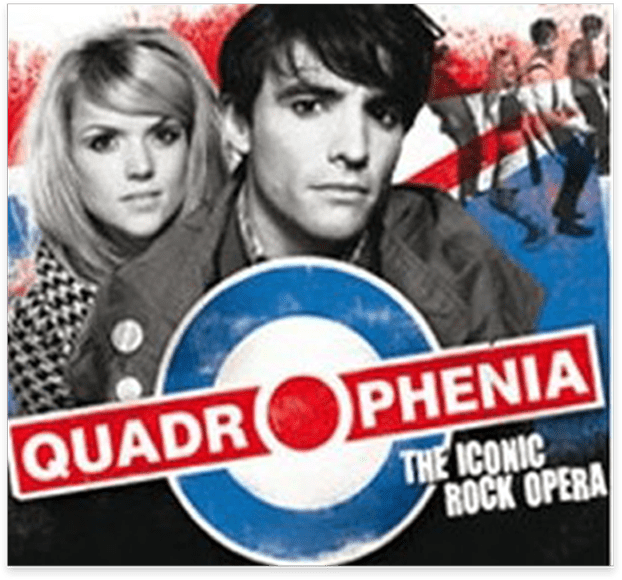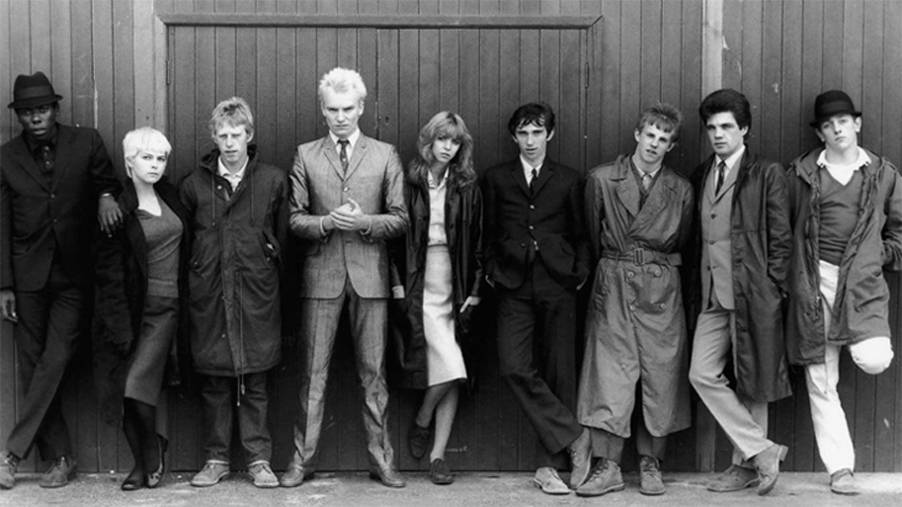

newsletter singup


Quadrophenia is a stage musical based on the sixth studio album by English rock band The Who, released on 19 October 1973, and a film of the same name, released in 1979. The album was the group's second full-length rock opera, and the story reveals social, musical and psychological events from an English teenager's perspective. The music and songs were composed by Pete Townshend and the story is set in London and Brighton in 1964 and '65. The name of the musical is a variation on the popular usage of the medical diagnostic term "schizophrenia" as dissociative identity disorder, which reflects the four distinct personalities of Jimmy, the story's protagonist, as well as the personalities of the four members of The WhoQuadrophenia is a stage musical based on the sixth studio album by English rock band The Who, released on 19 October 1973, and a film of the same name, released in 1979. The album was the group's second full-length rock opera, and the story reveals social, musical and psychological events from an English teenager's perspective. The music and songs were composed by Pete Townshend and the story is set in London and Brighton in 1964 and '65.
The name of the musical is a variation on the popular usage of the medical diagnostic term "schizophrenia" as dissociative identity disorder, which reflects the four distinct personalities of Jimmy, the story's protagonist, as well

HistoryAfter the rock opera was released in 1973, The Who attempted to perform the album on a supporting tour. However, the effort turned out to be disastrous because of the complexity of the production. The album's music made extensive use of synthesizers and sound effects, which meant the group had to work to backing tapes for live production. The album's music made extensive use of synthesizers and sound effects, which meant the group had to work to backing tapes for live performance. The band was constrained by playing to the tapes, and early performances were plagued by tape malfunctions. The band soon abandoned most of the rock opera in favor of their other hit songs.[1] Only a few of the album's songs would be performed regularly on the group's subsequent tours in 1975-6, 1979–80, 1981, 1982, and 1989.In 1994 Roger Daltrey, lead singer of The Who, celebrated his 50th birthday by performing a two-night spectacular of Who music at Carnegie Hall, followed by a major tour. This tour attracted attention to songs from The Who's Quadrophenia and gathered support for the staging of a major tour of the rock opera in 1996-1997.
In 1996 Pete Townshend was approached to produce Quadrophenia for The Prince's Trust concert at Hyde Park, London. He at first planned to perform the opera as a solo acoustic show using scenes from the film on backing screens, but after receiving offers of financing from Vespa, Townshend decided on a full-out production. The opera was performed with a large backing band, including Daltrey, John Entwistle on bass, Pete Townshend on acoustic guitar and vocals, Zak Starkey on drums, Rabbit Bundrick and Jon Carin on keyboards, Simon Townshend and Geoff Whitehorn on guitar and special guests including Phil Daniels as the Narrator/Jimmy, Gary Glitter as The Rocker, Adrian Edmonson as the Ace Face/Bellboy, Stephen Fry as the hotel manager, Trevor McDonald as the newsreader and Pink Floyd's David Gilmour as the bus driver. Gilmour also played additional lead guitar for that performance. A horn section and backing vocalists were included, along with other actors.ownshend on acoustic guitar and vocals, Zak Starkey on drums, Rabbit Bundrick and Jon Carin on keyboards, Simon Townshend and Geoff Whitehorn on guitar and special guests including Phil Daniels as the Narrator/Jimmy, Gary Glitter as The Rocker, Adrian Edmonson as the Ace Face/Bellboy, Stephen Fry as the hotel manager, Trevor McDonald as the newsreader and Pink Floyd's David Gilmour as the bus driver. Gilmour also played additional lead guitar for that performance. A horn section and backing vocalists were included, along with other actors.
videos
Quadrophenia - Official Trailer
Quadrophenia - Official Trailer
Quadrophenia - Official Trailer
you want to understand where the eternal battle between hunks and rockers comes from and where, magically, three or four years ago the parka jumped out;
you thought the Who were just “that stuff that my parents listened to”. You will change your mind;
you love Sting;
you thought that only your youth had been tragic-complicated or you are one of those: “when I was young it was completely different”. At the end of the show each generation runs into the same damn problems.and rockers comes from and where, magically, three or four years ago the parka jumped out;
you thought the Who were just “that stuff that my parents listened to”. You will change your mind;
you love Sting;
you thought that only your youth had been tragic-complicated or you are one of those: “when I was young it was completely different”. At the end of the show each generation runs into the same
Photos
NEWS
FREQUENTLY ASKED QUESTIONS
A. The name (Quadrophenia) is a variation on the term schizophrenia,to reflect the four distinct personalities of the character Jimmy, the opera's protagonist.
B. Quadrophenia is the sixth studio album by the band The Who, released as a double album on 26 October 1973 by Track Records. It is the group's second rock opera.
A. The album title is a play on quadraphonic sound, which was a recent invention at the time. Townshend: "The whole conception of Quadrophenia was geared to quadraphonic, but in a creative sort of way. I mean I wanted themes to sort of emerge from corners. So you start to get the sense of the fourness being literally speaker for speaker."
The equivalent is now called 4.0 surround sound. Four channels in which speakers are positioned at the four corners of the room, reproducing signals that are independent of one another. Quadraphonic audio was the earliest product in surround sound and thousands of quadraphonic recordings were made during the 1970s. It was a commercial failure, more to do with technical abilities at the time.
A. The main character of Quadrophenia is Jimmy, who has four personalities, or "personality extremes" or mood swings representing each member of the WHO.
- A tough guy ( Roger Daltrey)
- A romantic ( John Entwistle)
- A bloody lunatic ( Keith Moon)
- A beggar, a hypocrite ( Pete Townshend)
A. The film was called The Pain of Living
A. Sting.This was Sting’s first theatrical movie based performance.
A. London
- The film is set in London but the main activity of the film is shot in Brighton.
A. Michael
A. Mods and rockers were two conflicting British youth subcultures of the early/mid 1960s and 1970s. Media coverage of mods and rockers fighting in 1964 sparked a moral panic about British youth culture, and the two groups became widely perceived as violent, unruly troublemakers.
A. Peter ( Played by Gary Cooper )
A. Amphetamines. Most probably Dextroamphetamine sulfate which were popular in mod culture of the time
A. My Generation, written by Pete Townshend
The song was named the 11th greatest song by Rolling Stone Magazine on its list of the 500 Greatest Songs of All Time
The song was not released until 29th October 1965, a year after the setting of the film.
The song has been said to have "encapsulated the angst of being a teenager," and has been characterized as a "nod to the mod counterculture"
A. Because he’s a rocker
A. The role went to Phil Daniels
A. Because he leaps off a balcony
- Drug use…. They were clearly amphetamine because historically the Mod subculture was quite fond of the drug, and because the film very accurately depicts amphetamine psychosis.
- The pills most likely contain 5–10mg of dextroamphetamine sulfate because that was the most commonly used form at the time as it had been figured out to be less hard on their bodies than racemic benzedrine and methamphetamine had never been big in the UK (although was, and still is, available in the US as desoxyn, though benzedrine was more popular here).
- That all being said, the specific contents of those pills don’t matter because as Dr. Carl Hart found that the effects are almost identical and cannot be reliably distinguished by addicts. What is important is that they were abusing copious amounts of it, handfuls at a time and that is hard on your body and mind which, in addition to feeling like an outcast, is why Jimmy progressively deteriorated throughout the film.
A. ‘Heaven Can Wait’, a film not released until fourteen years after the events in the film.
1. Side One: ‘I am the Sea, The Real me, Quadrophenia, Cut my Hair,The Punk and the Godfather’.
2. Side Two: ‘I’m the One,The Dirty Jobs,Helpless Dancer,Is it in My Head,I’ve had Enough’.
3. Side Three: ‘5:15, Sea and Sand,Drowned,Bell Boy’.
4. Side Four: ‘Doctor Jimmy,The Rock,Love,Reign O’er Me’
A. Projectionist










